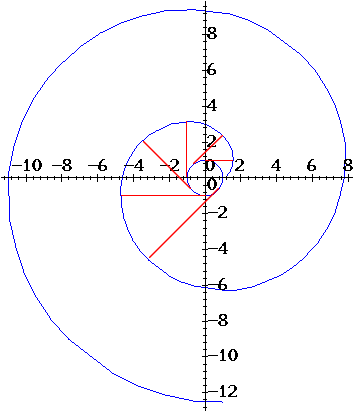The Involute
If you have a curve, f(t), in the plane, it's involute is the curve swept out by the the function's negative unit tangent vector scaled by it's arclength. The easiest way to picture this is by imagining the curve swept out as you unwind a taunt string from around the original function. Think about unwinding the thread from around its spool. The picture below shows a circle and its involute. The red lines show the negative tangent vectors. 
You can see that the shape of the involute is dependent on the starting point.
The Involute of the Cardioid
Now let's look at the involute of the cardioid. Try plotting the involute of the cardioid with the starting points t = 0, Pi/2, and Pi.
plot({[paraminvolute(1+cos(t), tstart, tstart+2*Pi), t = 0..2*Pi], [(1+cos(t))*cos(t), (1+cos(t))*sin(t), t = 0..2*Pi]}, scaling = constrained);
Question 5:
Look at the involute when the starting point is t = 0. What does the inner curve resemble?
What happens when the involute reaches the cusp?
Now apply the involute to the evolute of the cardioid with the involute starting at t = 0. Use plot({[paramevo(1+cos(t)), t=0..2*Pi], [involute(paramevo(1+cos(t), 0, 2*Pi), t=0..2*Pi)]} scaling = constrained); Trust us. This will work. It will take a while, and it will not plot the original curve 1+cos(theta).
Question 6:
What curve does the involute sweep out here? What property does the involute have in relation to the evolute? What factors affect this?
This property will hold for any curve as long as you choose the right starting point and range for t.
You're Finished!!!!!!